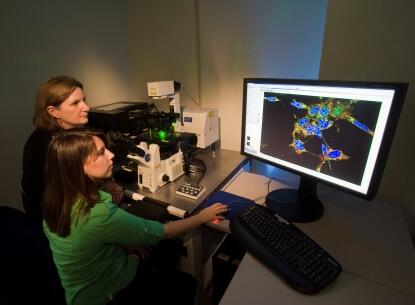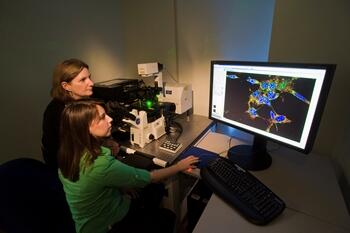
March 18, 2013
Researchers Identify Parkinson’s Disease Link
Article published in the Journal of Molecular Neurodegeneration
Share this story
Researchers at the Virginia Commonwealth University Parkinson’s and Movement Disorders Center have found that mitochondrial quality and functional capacity play an important role in Parkinson’s disease.
Patricia Trimmer, Ph.D., associate professor of anatomy and neurobiology and associate director of basic research for the Parkinson’s and Movement Disorders Center, and her research team used human cell lines containing mitochondrial DNA from Parkinson’s disease, or PD, patients to understand how mitochondrial dysfunction and Lewy bodies (diagnostic markers found in the brains of deceased individuals who had Parkinson’s disease) are involved in sporadic PD.
Lewy bodies are protein aggregates, or big clumps of misfolded proteins that develop inside nerve cells in patients with PD, but it is not known what role they play in the disease.
The research team used a human cytoplasmic hybrid, or cybrid, cell model to express mitochondrial DNA from individuals with sporadic PD to compare mitochondrial function in parent cell lines to cell lines enriched for the expression of Lewy bodies. The team expected a consistent improvement or loss of function in all of the cell lines enriched for Lewy bodies.

Different outcomes were discovered among the three cell lines enriched for Lewy bodies. One line showed improved function, one showed loss of function and one was unchanged. To find out why this happened, the mitochondrial quality, movement and functional capacity were examined to determine if there were any changes in the cell lines enriched for Lewy bodies.
The major finding of this study was the discovery that the mitochondrial DNA in cells with Lewy bodies determined if the enriched cells would be healthier, sicker or unchanged, not the Lewy bodies, as the team had hypothesized. The Lewy body-enriched cells with mitochondrial DNA were more functional than cells with lower levels of mitochondrial DNA.
These results demonstrated that mitochondrial DNA plays an important role in sporadic PD.
“This finding is an important piece of the puzzle in finding better treatments for Parkinson’s disease,” said Trimmer. “These results support our hypothesis that mitochondrial DNA play an important role in sporadic PD, and the next step will be to figure out what that role is.”
Trimmer and her team plan to further explore the role of mitochondrial DNA in cell function and its impacts on PD.
This study was published in the Journal of Molecular Neurodegeneration and can be read online: http://www.molecularneurodegeneration.com/content/8/1/6#.
This research was supported by a Morris K. Udall Parkinson’s Research Center of Excellence grant )7P50 NS039788-11) from the National Institutes of Health and the Parkinson’s and Movement Disorders Center Fund through the Medical College of Virginia Foundation.
Subscribe to VCU News
Subscribe to VCU News at newsletter.vcu.edu and receive a selection of stories, videos, photos, news clips and event listings in your inbox.










